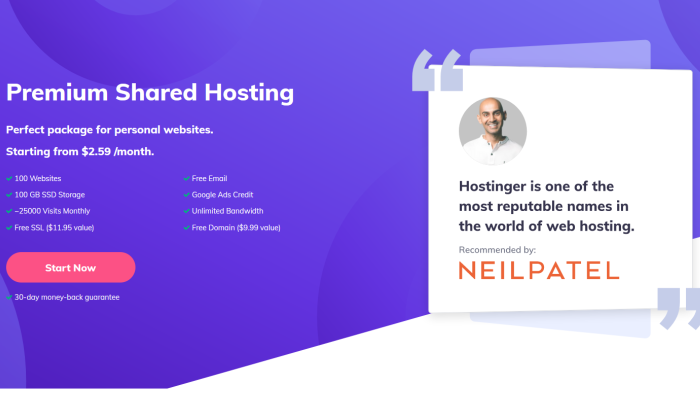
Disclosure: This content is reader-supported, which means if you click on some of our links that we may earn a commission.
If anyone’s going to see your website, it needs a domain. Simple as that.
If you don’t want to pay for a domain name, keep reading this post.
Your domain name is where your site lives on the internet. I use neilpatel.com, as you can see in your browser.
Obviously, you want something different. Something that’s your own.
In this post, I’ll walk you through how to get a domain name that aligns with your business and establishes your brand, and how to get it for free.
I’ve made this as simple as possible. Don’t worry if you aren’t familiar with this stuff. Just follow the steps and you will have a free domain name very quickly.
Your 2-Minute Cheat Sheet
Want a quick answer on how to get a free domain name? I’ll cut to the chase.
If you’re planning to start a blog or launch a website, you’ll need a web hosting company. When it comes to making a choice from the many available options, I suggest Hostinger.
Not only does the company provide excellent speed and uptime reliability, but it also offers a free domain name for the first year.
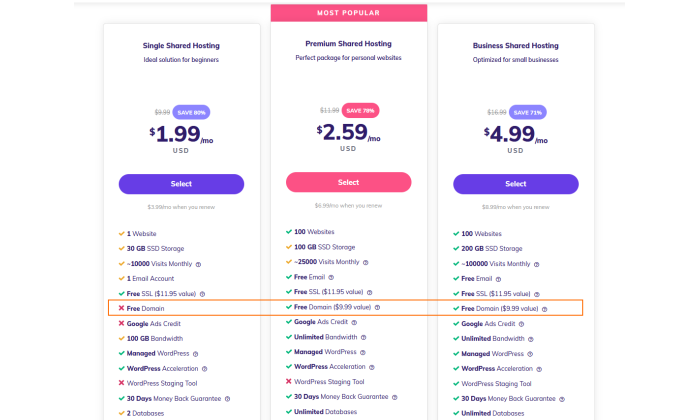
Get your domain and hosting set up in one fell swoop with Hostinger. You still have to pay for hosting (which you can lock in for under $3 per month), but you get the domain name for free.
You can create a Hostinger account and sign up by clicking here. With their easy guided setup, the whole process just takes a couple minutes.
After that, you’ll have hosting, a domain, and a basic website ready to go.
If your budget is really tight at the moment, you can also consider using a free subdomain.
This is where website builders like WordPress and Wix come into play. The only catch is that, instead of having a simple .com site like mine (NeilPatel.com), you‘ll have something like yourusername.wixsite.com/yoursiteaddress or yourdomainname.wordpress.com.

This isn’t an ideal situation. But it can be a viable option for when you want to experiment with free features of the website builder.
But if not having a clean .com is a non-starter, don’t worry. The process for getting set up with Hostinger and snagging your free domain is as simple as it can be.
Read on to follow the three easy steps to get a free domain name for your website.
You’ll be able to do all of this in one place with Hostinger. I will walk through some of your other options, but you may need to interface with multiple vendors to accomplish all of these steps.
Step 1: Go to Hostinger’s Website
The very first thing you need to do is head over to Hostinger by clicking here.
Click Start Now and you’ll be taken straight to the checkout page.
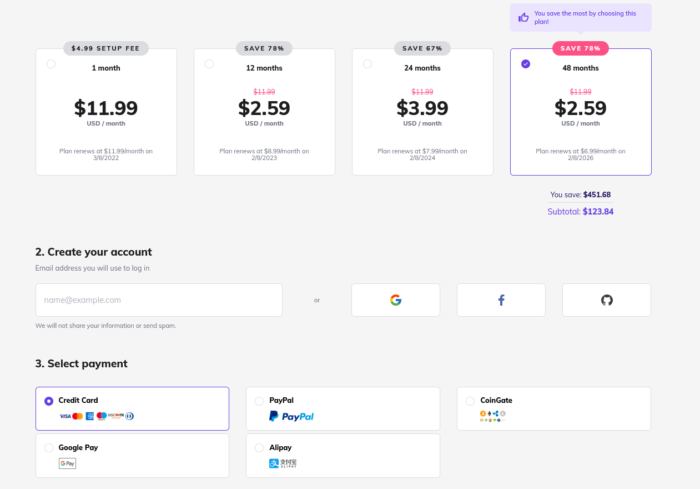
Conveniently, that checkout page is all set up with my recommendation. You’ll get premium shared hosting, which is the lowest-cost plan that also includes a free domain name.
My tip is select the longest term for the best rate. If you commit to four years of hosting upfront, you can lock in a really attractive rate of $2.59 per month.
Just click on the right-most box at the top to make sure you get the best deal.
Take a look at the add-ons below there to see if any are useful to you. None of them are absolutely necessary, but daily backups and priority support are helpful features and they’re reasonably priced.
After that, enter your payment information, click Submit Secure Payment, and then you’ll be onto setup.
Step 2: Select Your Hosting Type
With my special offer for Hostinger, you won’t have to select a hosting type on your own. The Premium shared hosting package is already chosen for you.
But if you need something more powerful, you might opt for another option.
Continue below to learn more about the different types of hosting options available and which one is best for your situation:
Shared Web Hosting
Shared hosting is best for beginners starting a brand new website.
They’re cheap and easily accommodate lower volumes of traffic. Your site gets hosted on the same server as other websites, so everyone saves money by sharing the same resources.
Shared hosting can best be compared to renting an apartment. It’s more affordable than owning your own house, and you don’t have to worry about maintaining the building.
The only downside of shared hosting is that one website on a shared server could occupy the majority of resources, ultimately hurting the performance of your website.
But if you’re just starting out and don’t expect a ton of traffic, shared hosting is almost always the best place to start.
Cloud Hosting
Cloud hosting gives you better site performance at an affordable rate.
You’re still sharing resources with other websites, but you’re sharing multiple servers instead of one. This prevents a single website or server from hogging all of the resources, so your site can still perform at a high level.
Cloud hosting is a step above shared hosting. It’s also more reliable in terms of site speed and uptime.
VPS Hosting
VPS hosting is built for growing websites that want better speed and performance.
VPS is an acronym that stands for “virtual private server.” While you’re still sharing a server with other websites, you’re not sharing any resources. VPS plans guarantee that a slice of resources on a single server are strictly dedicated to your website.
It’s a great option for websites that want more custom control at the server level without having to buy a server on their own. It also works great for sites that get frequent spikes in traffic.
Dedicated Server Hosting
Dedicated server hosting is the top-of-the-line option and comes at the highest price point.
It gives you exclusive access to a single server. You’re not sharing it with anyone else.
Dedicated servers are only useful for large organizations with high volumes of traffic. It also gives you full control over your hosting environment and customizations at the server level.
For the vast majority of you reading this guide right now, the Premium shared hosting package that’s pre-selected for you is going to be the best option.
Step 3: Claim Your Free Domain
After you’ve completed checkout and payment, you’ll be taken to your Hostinger control panel, hPanel.
There, you’ll see front-and-center an option for claiming your free domain.

Click Claim Domain to search for your preferred domain name. Once you see it, click the purple box next to it.
I’d encourage you to select a .com extension as it looks more professional and helps you appear more reliable to your visitors.
The only time that I’d consider an alternative domain extension is if the .com extension is already taken and you are absolutely set on the name.
Having a .com domain is particularly important for businesses—small blogs, personal sites, and side hustles may be able to save a few bucks by going for an alternative extension.
After that, you’ll just have to enter some basic information to register it. Fill out the form and submit it. Hostinger will take a few minutes to verify your registration information, then send you an email which will have a link to complete the verification.
With that, you’re all set on securing your free domain name!
There’s just one more thing I recommend.
Make sure to enable WHOIS protection. After you’ve completed verification, you’ll be taken to the section of your dashboard for your new domain name. Then, just look for the slider button under WHOIS Privacy and click it so it becomes purple and enabled.
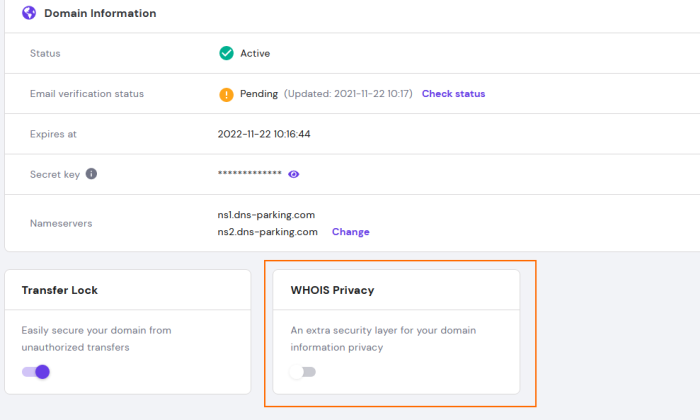
Doing this will conceal your name, email, phone number, and address from appearing on a public database.
And you’re done!
You now have an excellent hosting plan as well as a free domain. If you have not already started, then start now at Hostinger.
Other Ways to Get a Free Domain
For the sake of comprehensiveness, I’ll also discuss two other ways of getting a free domain. Although I don’t recommend them, it’s always good to know all of the options.
- Get a free subdomain
- Use a free domain registrar (not recommended)
I’ll explain each of these methods in greater detail below, including the reasons why they’re not recommended.
Method 1: Get a Free Subdomain
Several website builders offer subdomains, which is a personal domain that exists within an existing domain name.
Remember that movie Inception where Leonardo DiCaprio dreams that he is in a dream? Something similar happens here.
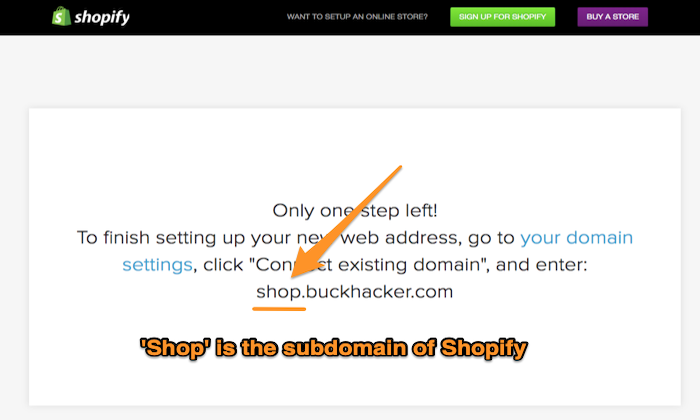
You end up getting a domain name within a domain name.
Site builders like Wix, Squarespace, and Weebly offer subdomains to their users. They have a free trial as well, so if you like their services, you can purchase their premium plans that include everything you require to build, launch, and manage a professional business website.
Out of the several perks on offer like drag-and-drop site builder, web hosting, templates, and search engine optimization (SEO) tools, you also get a free domain name.
But why do I still say this method is not ideal?
Let’s discuss this with an example.
Imagine you use a free website builder like Wix. You won’t have to pay for a domain, yes, but your site will have the Wix subdomain. It’ll look something like this:
yourusername.wixsite.com/yoursiteaddress
Suppose your Wix username is “My Stunning Website 123,” and the domain name you want is myblogsite. Here’s what you’ll get:
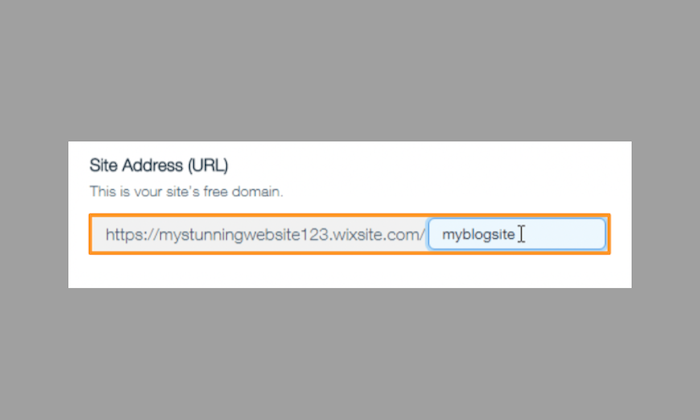
Think about it: Does that look professional? Have you seen any credible website have a domain like this?
That is why I’d only suggest this method if you want to experiment with your website builder’s free features or new updates.
WordPress is your other option, and luckily, is not as invasive as Wix. The format for a free WordPress subdomain is: yourdomainname.wordpress.com
This is a good option for situations when one cannot spend money, but it is not a viable long-term strategy. You want your domain name to be memorable and short–both of which aren’t possible when you use a subdomain.
The fact that your visitors won’t remember your domain or find it hard to remember is another disadvantage.
Method 2: Use a Free Domain Name Registrar (Not Recommended)
You can get a domain name from a free domain registrar, but it’s generally unsuitable. Especially if you want your domain to reflect a certain level of professionalism or trustworthiness.
You see, the truly free domains use uncommon extensions. For instance, you’ll get .tk instead of .com.
Your prospective customers would much prefer working with a domain name that reads yourbusiness.com instead of your yourbusiness.tk. And, it’s much easier to remember a .com than some domain extension few people have seen before.
Plus, you don’t own the domain name, which also defeats the purpose of launching a blog or a website.
However, if you do decide to take this route, you can check out Freenom, GetFreeDomain.Name and Dot TK.
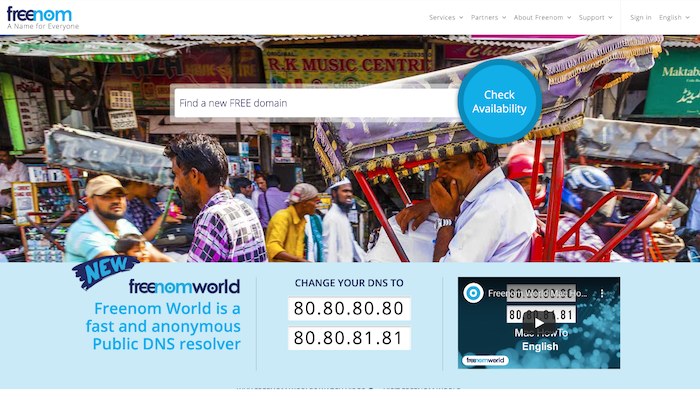
Several domain registrars will give you a free domain in exchange for running ads on your website. There is nothing wrong with running ads, but this just isn’t the best way to do it.
You don’t have any control over the ads (the kind of ads played, the length, etc.) or their placement. As a result, your visitors may not have the best experience on your website. This may even damage your SEO ranking as well.
In fact, even if you view the situation with a more optimistic viewpoint, it still isn’t viable.
Suppose you’re successful in driving high traffic to your website, and the ads get one million views. You won’t receive a single penny from those ads–all you get is a free domain.
Not a fair trade, right?
If you’re seriously toying with the idea of running ads on your website, I’d advise you to do so through a legitimate advertising network as it can be a great source of income. Don’t exchange ads for a free domain.
Important: Don’t Forget to Renew Your Domain!
Pay attention to how long the term is for your initial domain purchase. I cannot stress this enough.
Setting up a website or blog is hard work. You put in a lot of effort to find the perfect URL, design a website, and publish relevant content on it.
So, just imagine the horror when you get up and realize some random stranger has bought your domain out from under you.
The reason? You forgot to renew your domain.
Tragic.
Many people have made this mistake in the past, and it cost them dearly.
For instance, during one presidential election cycle, Jeb Bush and his team forgot to renew their domain JebBush.com, which Donald Trump successfully purchased and used to redirect Bush’s visitors to his own presidential election website. It was a disaster that Bush’s team could’ve easily averted.
How can you avoid this?
First, take note of your initial term. A lot of registrars default to a one-year registration, but with some you can buy five, 10, 20, or even 100 years at checkout.
The longer your initial term, the longer you don’t have to fret about renewal. Plus, you lock in the annual rate for the duration.
Second, and this is most important if you don’t buy a multi-year term at fist, is to make sure the domain renewal date is marked on your calendar with a reminder set for around one month in advance.
That way, you can prepare for renewal without your registration lapsing.
A one-month heads-up also gives you a chance to review the renewal rates from your domain registrar. Sometimes, that renewal rate jumps up quite a bit. If it’s more than you were expecting, at least you have a few weeks to consider your budget and options.
Last, if you don’t have a shoestring budget, I’d suggest just setting your domain to auto-renew.
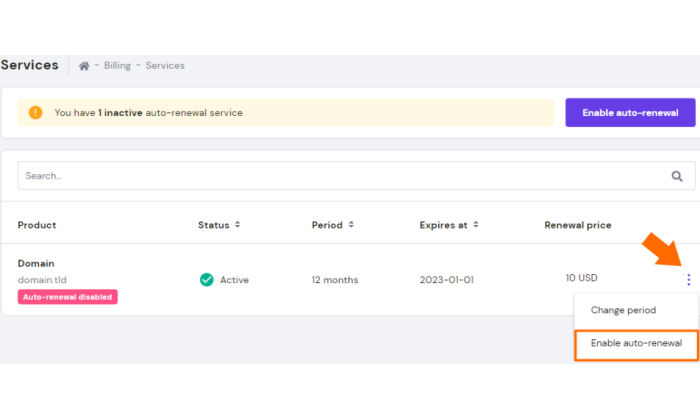
With most providers, you can find in your dashboard the expiry date of your domain, the renewal cost, and an option to enable auto-renewal. You can see in the image above that Hostinger makes this really easy in their services submenu under billing settings.
The other providers I’ve reviewed on this list also allow for auto-renewal, so you can set it and forget it with any one you choose.
I just suggest checking in on your domain’s renewal rate before the time comes, so you don’t get any unfortunate budgetary surprises if the rate spikes on you.
Conclusion
Hostinger is the best way to get a free domain name–one that you won’t have to surrender even if you switch web hosts.
The other way is to use a subdomain by using reliable and reputable web builders like WordPress and Wix.
Within seconds you’ll have a reliable web hosting service as well as a new domain for free. Trust me, saving a few dollars isn’t worth the hassle of looking unprofessional, running a spammy website, or getting hacked.






